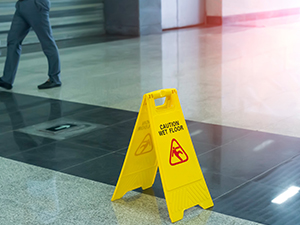We’ve all seen “SLIPPERY WHEN WET” signs posted at entry ways of industrial, commercial, and retail properties. Falls are completely avoidable, yet incredibly common. Sadly, they are the second leading cause of unintentional injury-related death, according to the National Safety Council. If you have natural stone floors or are considering having natural stone floors installed, you may be wondering whether this surface material is slippery. This article clears away misconceptions about the slipperiness of natural stone and provides suggestions regarding both new and existing installations.
The Physics of Slips
Slips are based on two surfaces, the flooring material and the shoes one is wearing (or bare feet). Just a bit of wetness between the bottom of a shoe and certain types of flooring can pose a very real hazard. You may have seen cartoons where a character slips on a banana peel. In real life, wetness on floors has a banana peel affect, whether the wetness comes from a spill, a pet accident, foot traffic on a rainy day, or even moisture from condensation. There are things you can do to minimize the risks, such as placing heavy duty mats near entry ways, being hyper-aware and vigilant about wiping up damp spots, and placing warning signs in conditions where wetness is likely to occur.
Natural Stone, Terrazzo, and Concrete
When it comes to natural stone, terrazzo, and concrete, the more polished and glossy the surface is, the less coefficient of friction (CoF) there is, that is, the more slippery the surface is. Likewise, if the stone has a honed or textured finish, it will have a higher CoF, which can minimize the likelihood of a slip and fall accident. If your floors get slippery when wet, talk to your natural stone technician. There are solutions available.
Professional Solutions
If you are having new stone installed, and you have your heart set on a reflective finish, you may want to select a lightly polished or highly honed finish instead of a high polish. For existing stone, your stone restoration technician can apply a treatment or refinish the floor to reduce the slipperiness. The tricky part is minimizing slipperiness while also preserving the reflective appearance of the stone. The more reflective you want the finish to be, the more ongoing maintenance will be required. Your stone restoration technician can make recommendations on the frequency of maintenance, depending on the type of stone you have, how much traffic it gets, and how determined you are to keep a finish that is inherently slippery. The bottom line is the rougher the finish, the less slippery the floor tends to be.
No Guarantees
As previously mentioned, why someone might slip involves two surfaces, but many factors can contribute to why someone might slip. For example, is there something on the floor or the bottom of a shoe, such as grease or residue from a cleaning solution? How much grip does the bottom of the shoe have? Is the pedestrian paying attention and being mindful or haphazardly moving along? Are there distractions in the environment, such as noise or poor lighting? Has the floor been properly installed and maintained? Stone restoration technicians can improve the slip resistance of your floor, but there is no guarantee someone will not slip and fall.
This article is one of a series of articles written and published on behalf of Surface Care PRO Partners.
